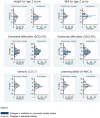Three-year change in the wellbeing of orphaned and separated children in institutional and family-based care settings in five low- and middle-income countries
- PMID: 25162410
- PMCID: PMC4146542
- DOI: 10.1371/journal.pone.0104872
Three-year change in the wellbeing of orphaned and separated children in institutional and family-based care settings in five low- and middle-income countries
Abstract
Background: With more than 2 million children living in group homes, or "institutions", worldwide, the extent to which institution-based caregiving negatively affects development and wellbeing is a central question for international policymakers.
Methods: A two-stage random sampling methodology identified community representative samples of 1,357 institution-dwelling orphaned and separated children (OSC) and 1,480 family-dwelling OSC aged 6-12 from 5 low and middle income countries. Data were collected from children and their primary caregivers. Survey-analytic techniques and linear mixed effects models describe child wellbeing collected at baseline and at 36 months, including physical and emotional health, growth, cognitive development and memory, and the variation in outcomes between children, care settings, and study sites.
Findings: At 36-month follow-up, institution-dwelling OSC had statistically significantly higher height-for-age Z-scores and better caregiver-reported physical health; family-dwelling OSC had fewer caregiver-reported emotional difficulties. There were no statistically significant differences between the two groups on other measures. At both baseline and follow-up, the magnitude of the differences between the institution- and family-dwelling groups was small. Relatively little variation in outcomes was attributable to differences between sites (11-27% of total variation) or care settings within sites (8-14%), with most variation attributable to differences between children within settings (60-75%). The percent of variation in outcomes attributable to the care setting type, institution- versus family-based care, ranged from 0-4% at baseline, 0-3% at 36-month follow-up, and 0-4% for changes between baseline and 36 months.
Interpretation: These findings contradict the hypothesis that group home placement universally adversely affects child wellbeing. Without substantial improvements in and support for family settings, the removal of institutions, broadly defined, would not significantly improve child wellbeing and could worsen outcomes of children who are moved from a setting where they are doing relatively well to a more deprived setting.
Conflict of interest statement
Figures


References
-
- The World Bank Group (2013) How we Classify Countries. Available: http://data.worldbank.org/about/country-classifications. Accessed 2013 Dec 5.
-
- UNICEF (2008) Orphans. Available: http://www.unicef.org/media/media_45279.html. Accessed 2013 Dec 5.
-
- UNICEF (2006) The State of the World’s Children 2006: Excluded and Invisible. Available: http://www.unicef.org/sowc06/pdfs/sowc06_fullreport.pdf. Accessed 2013 Oct 1.
-
- UNICEF (2009) Progress for Children A Report Card on Child Protection. Available: http://www.unicef.org/publications/files/Progress_for_Children-No.8_EN_0.... Accessed 2013 Dec 5.
Publication types
MeSH terms
Grants and funding
LinkOut - more resources
Full Text Sources
Other Literature Sources
Medical

